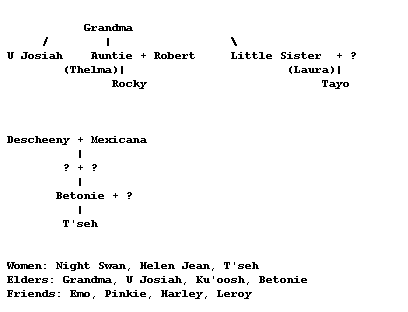
Silko, Leslie Marmon. Ceremony.
Notes
Kenneth Sherwood
Characters

Plot
Tayo's return and recovery from "battle fatigue," attempts to reassimilate into Laguna reservation life (to which he had never fully belonged). Must overcome differences with peers, redefine relationship to family, fulfill promise to Uncle Josiah, and complete ceremonies (Betonie - story, requiring his following of stars; Ku'oosh - telling of his story). His own intimacy with Ts'eh (an ethereal symbol of the feminine/ tradition/ nature/ shamanism) signals his success. Then he finally outwits the search-team come to bring him down from the mountains (cf Ts'eh's vision 232-3).
Form/Structure
Silko eschews a linear plot, partially through the device of Tayo's multiple flashbacks/flashforwards — discontinuity appropriate to Tayo's mental state; subsequently, the introjection of traditional stories sets up patterns of recurrence that allow for an alternative and appropriately 'cyclic' structure.
ETHNICITY
In Silko, the desire of affiliation and the acceptance of the community are both key for a marginal member like Tayo. Ultimately, he seems to choose his relation to family, culture, world - accepting or seeking the values that will define him in his decision to tell his story to the old men, to keep J's cattle and raise them, to use "we". (125) Note that while Auntie hypocritically recalls his mixed-race heritage in rejecting the call for a Shaman; Betonie and Night Swan advocate a kind of 'emergent' tradition (both being of mixed heritage); Ts'eh suggests that in the mountains distinctions of clan etc. are irrelevant (223).
Themes
Alienation / Reconcilliations:
War violence; modernity; mixed-parentage; religion. His ambivalent relation to family and culture since childhood effects Tayo; also the cultural pressures of boarding school: Rocky as assimilationist vs. Tayo. Tayo's successful "homing" is signalled by his growing familiarity with the land, and including his learning of indigenous place-names at the hand of Ts'eh.
The Sickness
A physical ailment as product of the war afflicts Tayo, but more. Betonnie sketches larger sense of a 'story of sickness', that the cure he enacts pertains not merely to Tayo but to the 'part' Tayo must play in completing the story. The residents of Gallup, his fellow Laguna G.I.s et al are also afflicted.
The Cure
Betonie's modified Navajo cure; Ku'oosh' scalp ceremony, both meant as purgatives not merely for Tayo but for the group/world. Various senses of connectedness and responsibility emphasized, such that the 'sickness' is seen as communal or global... loss of vision. Hence, Tayo's perceptions of his own complicity in causing the drought (cf. stories) not regarded as 'off-base'.
The Violence (Witchery - a powerful negative force that must be combatted)
Alienation of war, pow, failure to save Rocky; combine with post-war catastrophe in GI lives; and global destruction of atomic bomb, modernity as attacks on the practical way of life and the spiritual tradition of Native Americans (see Betonnie, Tayo's resistance to killing in conclusion.) Final passages on Uranium mines, testing of the A-bomb are signs of how near to destruction Tayo is.
Cultural Belonging
(See sickness.) Education produces alientation, as does "Auntie's" ambivalence and shame towards Laura's boy. (Christianity gently critiqued, for sense of individual guilt/salvation and Auntie's pride; cf. Grandmother's insistence on a traditional cure for Tayo, against Auntie's wishes.) Night Swan, Betonnie (affirm Tayo's 'hybrid' identity), Ts'eh's healing also brings Tayo into relation with his past/identity. The pursuit of Josiah's cattle is also a redemptive act, fulfilling a promise but also playing out Betonnie's vision of stars/cattle/woman.
SYMBOLS